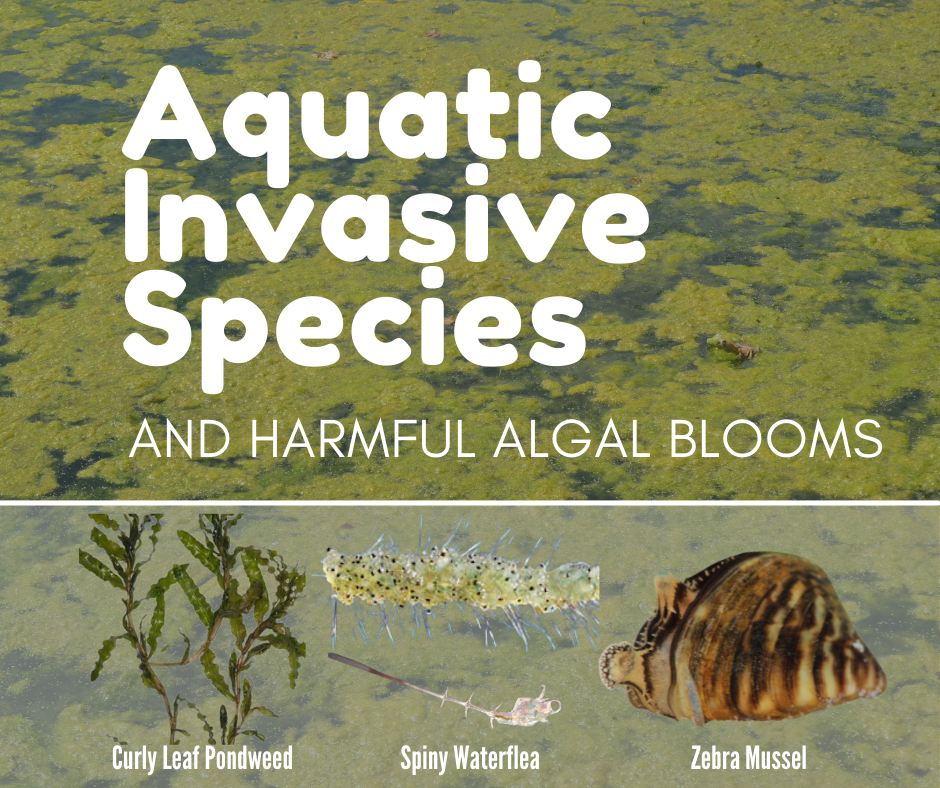What is a Harmful Algal Bloom
A harmful algal bloom (HAB) is a large-scale, visible algal bloom in freshwater produced by a group of bacteria called cyanobacteria or blue-green algae. These types of blue-green algae are capable of producing toxins that can cause health hazards. In freshwater lakes, excessive phosphorus loading into a water body allows HABs to occur. Blooms of concern typically appear as spilled paint, pea soup, floating dots, or surface streaks.

What to Do if You Find a Harmful Algal Bloom
- Call DEC’s HAB Program: 518-402-8179
- Fill out a DEC Suspicious Algal Bloom Report Form online and submit to HABsInfo@dec.ny.gov. Be sure to include
pictures if possible. - Health effects should be reported to your county health department or
harmfulalgae@health.ny.gov - For more information visit the DEC HAB webpage.
What Role Can an Aquatic Invasive Species Play
Invasive plants and animals alter typical ecosystem processes as they tend to grow as monocultures and/or outcompete native species. Some aquatic invasive species alter the invaded ecosystems in ways that assist the growth of harmful algal blooms (HABs).
Examples of Aquatic Invasive Species That Influence Algal Blooms

Zebra mussels are filter feeders, feeding primarily on phytoplankton, or algae living in the water column. An individual mussel can filter 1-2 liters of water in one day. As a result, lakes invaded by zebra mussels tend to experience an improvement in water clarity. However, zebra mussels are able to selectively reject phytoplankton that they aren’t interested in eating, typically cyanobacteria. Zebra mussels eat favorable, harmless green algae and allow cyanobacteria to grow, persist, and potentially produce HABs (Grand Valley State University).

Curly leaf pondweed is the only invasive of over 30 Potamogeton, or pondweed, species in New York. In the spring, it’s typically the first plant to begin growing in the littoral zone, or the area of a lake where plants are able to grow because sunlight hits the bottom. This gives curly-leaf pondweed a competitive advantage for space and resources over native plants. Curly leaf pondweed dies back around late June– early July. Large synchronous die-offs of a dense plant bed cause oxygen loss in bottom waters due to increased decomposition. Oxygen loss a.k.a. benthic hypoxia, leads to the release of phosphorus from bottom sediments. This internal loading of phosphorus allows heightened algal growth and potentially HABs (Makarewics et al 1994).

Spiny waterfleas are large zooplankton, or microscopic animals living in the water column. They eat native zooplankton which are important components of the lake food web as they eat algae, controlling their growth. If spiny water flea becomes dense in a lake they will eat large quantities of zooplankton. This allows algae to grow uncontrolled. With increased algal growth, most lakes experience a subsequent increase in cyanobacterial growth. Spiny waterflea compete with small fish for food and are not a nutritious food source for gamefish (Strecker 2016).



